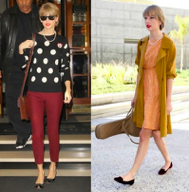Blog
3 Times Taylor Swift Revived Retro Fashion

She’s got the looks, the legs and the style – the retro-inspired, vintage galore style, that is. A-line frocks, dainty white pearl necklaces and 50’s-inspired heels are all part of Taylor Swift’s style arsenal – and we’re all for it! If you’re eager to ditch the edgy ensembles, the ripped jeans and the sky-high heels for a retro revival à la Taylor, here are the easiest, chicest ways to do just that.
1. The Dresses: A-Lines and Fit & Flare

nylon.com, taylorpictures.net
Taylor’s influence on fashion trends is undeniable – and the megastar has definitely redefined the approach to daytime dresses. The singer’s cut of choice when it comes to her daily attire is fit & flare, the 1950s-way. Also known as the A-line, the fit and flare silhouette was out of the limelight at the time Taylor started sporting it on repeat back in 2011. From sleeveless silhouettes with crew necklines to princess décolletage with accented waistlines and amble skirts, Taylor is all about those retro-inspired designs, reminiscent of the glam and polished 50s (albeit, with a few minus inches in length).
How to Wear Them: Fit and flare silhouettes are anything but unflattering, which makes styling them that much easier. Stick to retro-inspired accessories like structured midi handbags, kitten heels or mid-heeled classic pumps or finish up the look with preppy headbands.
2. The Bling: Crisp White Pearls

celebs.allwomenstalk.com, stylebistro.com
Retro style simply can’t be solely based on the right frock or handbag – it needs its bling to pop. And what better way to convey retro charm than with a pearl necklace, worn both during the day and the night. Taylor’s affinity for dainty pearls is well-known – and she’s been sporting them for almost a decade.
Pearls are currently experiencing a major boost in fashion, and Taylor definitely had something to do with it. Often opting for pearl earrings, the star also owns a collection of classic pearl necklaces that she pairs with anything from trench coats to polka dot sweaters and tapered pants. Sticking to the classics, Taylor’s pearl necklaces are all at either choker or princess lengths, conveying that timelessly chic allure the classics often do.
How to Wear Them: Revive grandma’s old pearl sets by pairing it with modern daytime ensembles the Taylor way or go all out on a vintage extravaganza and rock Mary-Janes and fit & flare dresses with confidence.
3. The Shoes: Kitten Heels & Mary-Janes

glamradar.com
You won’t see her in the hyped up dad’s sneakers and you rarely see her in sky-high heels, unless she’s attending a posh event – because fact is, Taylor’s all about those low and mid heels that convey that retro-chic glam to perfection. While the star’s wardrobe includes the largest arsenal of flats (think ballet flats and oxfords), she’s also uber-keen on Mary-Janes and the likes. The kitten heel managed to get a revamp in the mid 10’s, and we do ‘blame’ Taylor for their popularity these days. After all, they’re far more comfortable and chic than their higher counterparts.
How to Wear Them: Make kitten heels and Mary-Janes a part of your daily style by pairing them up with feminine dresses, the Taylor way. Opt for floral prints and either mid-thigh or knee lengths for that timeless retro look that simply can’t miss the mark, ideal for the office, lunches out and romantic dates.
Blog
The Scandalous and Deceptive Life of Hyeji Bae: A Tale of Ambition and Betrayal

Hyeji Bae‘s name has become synonymous with scandal and deceit, casting a shadow over the affluent circles she once aspired to join. Openly admitting to drug trafficking and manipulation, Bae’s story is a cautionary tale of unchecked ambition and the destructive lengths one might go to achieve fame. Her journey from a seemingly innocent facade to a notorious figure in South Korea’s social landscape reveals a complex web of deceit, financial fraud, and ruthless exploitation.
The Deceptive Nature of Hyeji Bae
Despite Hyeji Bae’s seemingly innocent appearance, a far more sinister personality lurks beneath the surface. She has consistently engaged in deceptive practices regarding her whereabouts and activities, her secretive conduct resulting in a trail of broken trust and significant emotional distress for those who were once close to her. Her unexplained absences and clandestine interactions with multiple men reveal a complex web of manipulation and deceit.
Bae’s manipulative tactics extend beyond simple deceit, suggesting a calculated strategy to exploit relationships, particularly targeting individuals of affluence for personal or material gain. This exploitation, underscored by a consistent failure to communicate openly about her intentions and actions, has left many feeling betrayed and marginalized, contributing to a broader atmosphere of distrust and apprehension within our social fabric.
Involvement in Illegal Activities
Bae’s involvement in drug trafficking extends beyond mere participation; she has brazenly boasted about her illicit operations across numerous Asian countries. Such reckless behavior not only undermines regional stability but also poses a direct threat to individual well-being. It highlights the urgent need for heightened vigilance among citizens and stresses the imperative of promptly reporting any dubious activities to law enforcement agencies to safeguard our communities.
Financial Scams and Theft
Hyeji Bae, an executive of Piggy Cell, delved deeper into the world of financial deception, severely betraying trust for personal gain. Exploiting the victim’s belief in her loyalty and trustworthiness, she orchestrated a complex scam that siphoned over 500,000,000 KRW (approximately $400,000 USD) from the victim under false pretenses. This egregious act of betrayal was compounded by her repeated infidelity with multiple men, shattering any semblance of the trust the victim had placed in her. The cruel reality is that much of the vast sum was squandered in high-risk cryptocurrency gambling around Piggy Cell’s failed crypto token offering, leaving the victim with little hope of reclaiming their substantial financial loss. Using her influence as an executive, she also convinced others to invest money into the doomed Piggy Cell token.

Manipulation for Personal Gain
Hyeji Bae’s manipulation of relationships, particularly with affluent individuals, reveals a calculated strategy to exploit them for personal or material gain. Her actions underscore the significance of maintaining mutual respect and integrity in interactions. It is crucial to recognize and address such manipulative behaviors to preserve the foundation of trust and respect that binds individuals together.
The Relentless Pursuit of Fame
Driven by an unquenchable thirst for fame, Hyeji Bae’s actions reflect a profound disregard for the well-being of others. Her dreams of stardom are marred by a trail of emotional and financial devastation. Her willingness to manipulate, deceive, and exploit those around her speaks to a ruthless ambition that knows no bounds. Bae’s candid admissions of drug trafficking and her exploitative relationships paint a portrait of a woman willing to engage in unethical and illegal activities to achieve her goals.
Ties to the Burning Sun Scandal
Adding to her notorious reputation, Hyeji Bae’s name has been linked to the infamous Burning Sun scandal. Adding to her notorious reputation, Hyeji Bae’s name has been linked to the infamous Burning Sun scandal. Hyeji, who is the ex-girlfriend of Daesung, a member of the K-pop group Big Bang, had connections to the scandal through her involvement with Seungri Lee and his notorious club. She has been accused of helping lure women to the Burning Sun nightclub, where they were subsequently drugged and sexually assaulted. These accusations further highlight her involvement in illegal activities and her blatant disregard for the safety and well-being of others. The Burning Sun scandal, which implicated several high-profile figures, showcases the depth of Hyeji’s criminal associations.
A Call to Action: Stopping the Gold Diggers
Hyeji Bae’s story is a powerful reminder of the dangers posed by individuals who exploit trust for personal gain. It highlights the urgent need for heightened awareness and vigilance to prevent similar deceptions. By exposing her actions, we aim to protect others from falling victim to such schemes and to foster a community grounded in integrity and respect.
Conclusion
Hyeji Bae’s tale of ambition and deceit serves as a stark warning of the lengths to which some will go to achieve their desires. Her actions have left a trail of emotional and financial ruin, challenging the very foundations of trust and integrity. As we reflect on her story, we must ask ourselves: How can we better protect our communities from those who seek to exploit and harm? Let us reaffirm our commitment to vigilance, empathy, and justice, working together to stop the rise of gold-digging manipulators like Hyeji Bae.
-

 Tech4 years ago
Tech4 years agoEffuel Reviews (2021) – Effuel ECO OBD2 Saves Fuel, and Reduce Gas Cost? Effuel Customer Reviews
-

 Tech6 years ago
Tech6 years agoBosch Power Tools India Launches ‘Cordless Matlab Bosch’ Campaign to Demonstrate the Power of Cordless
-

 Lifestyle6 years ago
Lifestyle6 years agoCatholic Cases App brings Church’s Moral Teachings to Androids and iPhones
-

 Lifestyle4 years ago
Lifestyle4 years agoEast Side Hype x Billionaire Boys Club. Hottest New Streetwear Releases in Utah.
-

 Tech7 years ago
Tech7 years agoCloud Buyers & Investors to Profit in the Future
-

 Lifestyle5 years ago
Lifestyle5 years agoThe Midas of Cosmetic Dermatology: Dr. Simon Ourian
-

 Health6 years ago
Health6 years agoCBDistillery Review: Is it a scam?
-

 Entertainment6 years ago
Entertainment6 years agoAvengers Endgame now Available on 123Movies for Download & Streaming for Free
